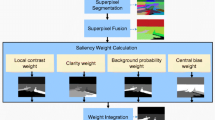Abstract
Saliency detection has attracted increasing attentions in computer vision. Although most traditional saliency models can effectively detect the salient objects in natural images, it is still a burning problem in low contrast images, for low lightness and few color information limit the applicability of these models. Different from conventional models, which are not robust on weak light environments, the proposed method uses the particle swarm optimization (PSO) algorithm to estimate the image saliency. First, the covariance feature is used to compute the local saliency of each superpixel region. Then, the PSO search is executed to measure the image saliency in a global perspective. Finally, the graph model is constructed to optimize the saliency value. As the proposed model incorporates both local and global cues, the generated salient objects have well-defined boundaries and uniform inner regions. Experimental results show that the proposed salient object detection model yields better results than eleven state-of-the-art saliency models on low contrast images.
Access this chapter
Tax calculation will be finalised at checkout
Purchases are for personal use only
Similar content being viewed by others
References
Liu, T., Sun, J., Zheng, N.-N., Tang, X., Shum, H.-Y.: Learning to detect a salient object. In: CVPR, pp. 1–8 (2007)
Kennedy, J., Eberhart, R.: Particle swarm optimization. In: ICNN, pp. 1942–1948 (1995)
Gao, H., Pun, C.-M., Kwong, S.: An efficient image segmentation method based on a hybrid particle swarm algorithm with learning strategy. Inf. Sci. 369, 500–521 (2016)
Uguz, S., Sahin, U., Sahin, F.: Edge detection with fuzzy cellular automata transition function optimized by PSO. Comput. Electr. Eng. 43, 180–192 (2015)
Jiji, G.W., DuraiRaj, P.J.: Content-based image retrieval techniques for the analysis of dermatological lesions using particle swarm optimization technique. Appl. Soft Comput. 30, 650–662 (2015)
Itti, L., Koch, C., Niebur, E.: A model of saliency-based visual attention for rapid scene analysis. TPAMI 20(11), 1254–1259 (1998)
Zhang, J., Wang, M., Zhang, S., Li, X., Wu, X.: Spatiochromatic context modeling for color saliency analysis. TNNLS 27(6), 1177–1189 (2016)
Xia, C., Qi, F., Shi, G., Wang, P.: Nonlocal center-surround reconstruction-based bottom-up saliency estimation. Pattern Recognit. 48(4), 1337–1348 (2015)
Xu, X., Mu, N., Chen, L., Zhang, X.: Hierarchical salient object detection model using contrast based saliency and color spatial distribution. MTA 75(5), 2667–2679 (2015)
Liu, J., Wang, S.: Salient region detection via simple local and global contrast representation. Neurocomputing 147, 435–443 (2015)
Tong, N., Lu, H., Zhang, Y., Ruan, X.: Salient object detection via global and local cues. Pattern Recognit. 48(10), 3258–3267 (2015)
Huang, K., Wang, L., Tan, T., Maybank, S.: A real-time object detecting and tracking system for outdoor night surveillance. Pattern Recognit. 41(1), 432–444 (2008)
Han, J., Yue, J., Zhang, Y., Bai, L.-F.: Salient contour extraction from complex natural scene in night vision image. Infrared Phys. Technol. 63, 165–177 (2014)
Achanta, R., Shaji, A., Smith, K., Lucchi, A., Fua, P., Susstrunk, S.: SLIC superpixels compared to state-of-the-art superpixel methods. TPAMI 34(11), 2274–2282 (2012)
Xu, X., Mu, N., Zhang, H., Fu, X.: Salient object detection from distinctive features in low contrast images. In: ICIP, pp. 3126–3130 (2015)
Hou, X., Zhang, L.: Saliency detection: a spectral residual approach. In: CVPR, pp. 1–8 (2007)
Tuzel, O., Porikli, F., Meer, P.: Region covariance: a fast descriptor for detection and classification. In: Leonardis, A., Bischof, H., Pinz, A. (eds.) ECCV 2006. LNCS, vol. 3952, pp. 589–600. Springer, Heidelberg (2006). doi:10.1007/11744047_45
Forstner, W., Moonen, B.: A metric for covariance matrices. In: Geodesy-The Challenge of the 3rd Millennium, pp. 299–309 (2003)
Erdem, E., Erdem, A.: Visual saliency estimation by nonlinearly integrating features using region covariances. J. Vis. 13(4), 11, 1–20 (2013)
Murray, N., Vanrell, M., Otazu, X., Parraga, C.A.: Saliency estimation using a non-parametric low-level vision model. In: CVPR, pp. 433–440 (2011)
Hou, X., Harel, J., Koch, C.: Image signature: highlighting sparse salient regions. TPAMI 34(1), 194–201 (2012)
Shen, X., Wu, Y.: A unified approach to salient object detection via low rank matrix recovery. In: CVPR, pp. 853–860 (2012)
Goferman, S., Zelnik-Manor, L., Tal, A.: Context-aware saliency detection. TPAMI 34(10), 1915–1926 (2012)
Margolin, R., Tal, A., Zelnik-Manor, L.: What makes a patch distinct? In: CVPR, pp. 1139–1146 (2013)
Yang, C., Zhang, L., Lu, H., Ruan, X., Yang, M.-H.: Saliency detection via graph-based manifold ranking. In: CVPR, pp. 3166–3137 (2013)
Zhu, W., Liang, S., Wei, Y., Sun, J.: Saliency optimization from robust background detection. In: CVPR, pp. 2814–2821 (2014)
Tong, N., Lu, H., Yang, M.: Salient object detection via bootstrap learning. In: CVPR, pp. 1884–1892 (2015)
Qin, Y., Lu, H., Xu, Y., Wang, H.: Saliency detection via cellular automata. In: CVPR, pp. 110–119 (2015)
Jiang, P., Vasconcelos, N., Peng, J.: Generic promotion of diffusion-based salient object detection. In: ICCV, pp. 217–225 (2015)
Acknowledgements
This work was supported by the Natural Science Foundation of China (61602349, 61440016, and 61273225), Hubei Chengguang Talented Youth Development Foundation (2015B22), and the Educational Research Project from the Educational Commission of Hubei Province (2016234).
Author information
Authors and Affiliations
Corresponding author
Editor information
Editors and Affiliations
Rights and permissions
Copyright information
© 2017 Springer International Publishing AG
About this paper
Cite this paper
Mu, N., Xu, X., Zhang, X., Chen, L. (2017). Particle Swarm Optimization Based Salient Object Detection for Low Contrast Images. In: Liu, D., Xie, S., Li, Y., Zhao, D., El-Alfy, ES. (eds) Neural Information Processing. ICONIP 2017. Lecture Notes in Computer Science(), vol 10636. Springer, Cham. https://doi.org/10.1007/978-3-319-70090-8_61
Download citation
DOI: https://doi.org/10.1007/978-3-319-70090-8_61
Published:
Publisher Name: Springer, Cham
Print ISBN: 978-3-319-70089-2
Online ISBN: 978-3-319-70090-8
eBook Packages: Computer ScienceComputer Science (R0)




